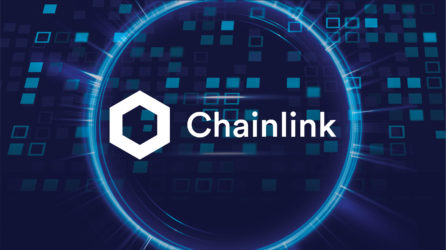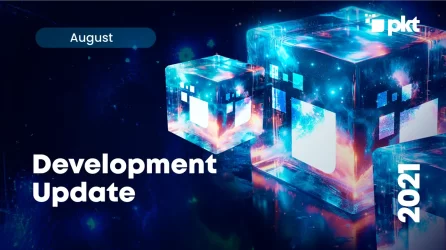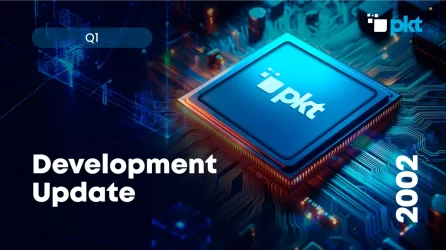
Chainlink is a cryptocurrency that connects outside data from oracles to blockchain smart contracts. This way anyone can access truthful real-world data. Chainlink technology enables blockchains to access, connect to, and verify external data sources. Additionally, the decentralized system empowers oracles to use multiple subcontracts, which accumulate and verify the quality of the information, accuracy, and ensures feeds from an unlimited number of oracle contracts and trustworthy nodes. Chainlink’s ability to accurately and verifiably source information from third parties makes it a powerful technology in the crypto space.
Payments within the Chainlink ecosystem are made using LINK tokens. The total LINK supply is 1 billion tokens.
Media exposure: As with any cryptocurrency, the power of media can positively or negatively affect its price. Positive press is known to help increase demand, and negative news can panic investors and may trigger price declines. Generally, positive media exposure and good macro market conditions can drive awareness which can increase buyer-side demands. Contrarily, any bad market news or alarming socioeconomic events are known to cause selloffs.
Chainlink’s supply and demand: Supply and demand dynamics can influence the token price. The higher the demand for the token, the lower the supply, which may result in a higher price. If LINK has a low demand and high supply, the token value can decrease.
The utility of Chainlink: Use cases and adoption of Chainlink technology can increase the token’s value. The more people who use LINK as a method for transactions, the more the token’s demand. As demand increases and supply is reduced, this can result in a higher overall spot price. Moreover, any notable partnerships with high-profile projects or companies could result in price changes for the token.
To buy Chainlink, you need to create an account on a cryptocurrency exchange that trades Chainlink. You can choose from different exchange platforms online, including Binance, Kraken, Coinbase, Kucoin, etc. It’s best to choose the trading platform you’re most comfortable with. Some trading platforms also have a mobile app that can be downloaded for convenience.
To create an account, some personal information is required to verify your identity. It’s common for a crypto exchange to request your full name, address, proof of residence, email address, proof of ID, and possibly a facial scan. For extra security, setting up two-factor authorization is advised. Once the account is activated, you must complete an identity verification process to deposit fiat currency into the exchange. However, most exchanges allow you to fund your account with cryptocurrencies, such as stable coins, Bitcoin, or other tokens traded on the exchange. Once your account is funded with fiat or cryptocurrency, you can purchase LINK tokens.
In addition to purchasing LINK through trading exchanges like Binance, Kraken, Coinbase, etc., you can also buy from cryptocurrency brokers. With these types of transactions, the broker will take a percentage as a commission. An investor can also trade LINK peer-to-peer in an OTC trade. OTC trading should always use a trusted escrow to ensure that both sides complete the transaction safely and successfully.
There is no specific time to buy Chainlink. Every minute the price can go up or down. When the token first began trading in 2017, it was listed for one penny. In May 2021, the token traded at an all-time high of $52.20.
An investor should research each cryptocurrency to know when to buy. Ideally, you may want to buy in at the low end of the average price when the markets are down. You can follow official websites and popular social accounts such as a chain.link and blog.chain.link to help determine the price movement of Chainlink. You can also research technical analysts on Twitter and YouTube who analyze LINK charts and movements.
Before buying, selling, and trading Chainlink or cryptocurrencies in general, here are some of the things that one may consider:
Investing in hardware or software:
Which wallet should you use? Exchanges have built-in wallets but unless the tokens are being actively traded it is better to keep your cryptocurrency in a secure hardware or software wallet. It can also be risky to store your cryptocurrency on an exchange platform for a long period.
Comparing the trading cost: Buying and selling cryptocurrencies has transactional costs. In buying or selling LINK, it is crucial to understand the transaction fees paid to the exchange platform on each trade. There can also be withdrawal fees incurred to send your LINK tokens off the exchange platform. Converting fiat money into LINK tokens may take some time and may can as much as 2 to 5 percent of the total amount transferred or exchanged.
Consider safety and security: It is wise to choose a cryptocurrency exchange with high security, such as two-factor authentication (2FA). Setting up 2FA will help protect your account from being accessed and funds being withdrawn without your knowledge. It is also important to check on the daily deposit and withdrawal limits. Cryptocurrency is known to be highly secure, however, any given exchange or wallet could have security vulnerabilities, and it’s vital to do your research beforehand.
Easy navigation of the trading platform: For beginners, it is especially crucial to choose an easy-to-navigate, and user-friendly platform. As an investor, you must be familiar with and understand the different features of each exchange platform, as well as the risk and account limits. Often, these exchanges have demos that provide more insight into the basic functions of the trading platform.
Growth Expectations: One of the most important things to consider is the potential range for crypto currency’s value to rise and by how much. Of course, it is hard to determine if a cryptocurrency will increase or decrease in value. But if you think about the crypto market as a whole and then look at the market share of any given cryptocurrency to its potential utility and adoption, it can give you an indication of potential growth.
Between 2020 and 2021, Chainlink maintained its position in the top of 30 largest cryptocurrencies in the world. As the global crypto market cap increased and Chainlink’s token adoption surged, it left room for further price appreciation. While Chainlink has shown steady growth over the years, it has stiff competition to overcome from other oracle projects.
For those looking for projects with greater potential, one may want to consider looking at other altcoins that have not yet gained the popularity and market status of Chainlink.
Altcoins are other cryptocurrencies aside from Bitcoin. Bitcoin, as we know, was one of the first cryptocurrencies ever created and dominates around half of the total crypto market share in value. As the altcoin market continues to grow, Bitcoin can lose its dominance due to the rising popularity of altcoins.
As of March 2022, CoinMarketCap estimates that over 57 percent of the crypto market are altcoins. Examples of altcoins are Ethereum, Cardano, Solana, Polkadot, Ripple, Vechain, and PKT Cash. There are different kinds of altcoins, such as security tokens, utility tokens, stablecoins, and mined coins.
Ethereum (ETH) is the second-most representative coin after Bitcoin. It alone occupies over 18% of the cryptocurrency market. Apart from being one of the most voluminous currencies, Ethereum is also a great facilitator. It serves as the building block for many cryptocurrencies and helps execute decentralized smart contracts, the backbone of the DeFi economy. Tokens that build themselves on Ethereum are known as ERC–20 tokens. It is a compliance standard, and thousands of ERC-20 tokens have been launched so far. LINK is an ERC-20 token.
Cardano (ADA) is a more energy-efficient currency than Bitcoin because it leverages the Proof-of-Stake consensus algorithm and not the proof of work used by Bitcoin. The ADA currency scores are immensely high in their decentralization potential. After a 2020 upgrade, Cardano had become more decentralized than many other large blockchains. Subsequently, it had its Alonzo hard fork launch allowing users to develop and deploy smart contracts, allowing native dApps to be built on blockchain.
Solana (SOL) leverages proof-of-history (PoH) consensus algorithms, allowing greater scalability and usability. It comes with a short processing time and decreased transaction validation time. Its capacity to save time is one of the reasons why Solana is preferred by many institutional users. Moreover, faster processing does not mean increased transaction costs. Many crypto-experts view Solana as a competitor to Ethereum.
Polkadot (DOT) is the native token of the Polkadot network that has a sharded multichain architecture and can process many transactions on several chains simultaneously. The community-oriented governance system of the network ensures that token holders get a chance to have their say on how the network will be run. Polkadot’s growth potential also stems from its successful parachain auctions that support a host of winning projects such as Acala, Moonbeam, Astar, Parallel, and Clover.
Ripple (XRP) is the native token of Ripple. Ripple helps conduct money transfers and occupy the space traditionally inhabited by banks. It allows you to transfer money at a very low cost with a transaction time of fewer than five seconds. XRP uses a ledger consensus protocol which is more centralized and efficient in increasing speed and reducing transaction cost.
VeChain (VET) is the native token of VeChain. VeChain also has another in-house token VeThor (VTHO). This dual-token mechanism helps VeChain get rid of network congestion and absorb price fluctuation shocks. VET facilitates transactions and a few other activities, while VTHO works as a gas token. One of the benefits of holding VET is that you can generate a passive VTHO income with VET.
PKT Cash ($PKT) is an exciting new altcoin that is rising in popularity. Its core technology enables people to monetize their internet bandwidth and provides completely decentralized internet access powered by the people. PKT is the world’s first and only Layer-1 blockchain powered by bandwidth. As more people connect to the PKT Network, this creates an alternative way for people to pay for internet services without requiring a traditional ISP. This type of innovation empowers people to access cheaper internet compared to traditional ISPs.
PKT is listed on major trading platforms Bittrex Global and BitMart. You can also buy wrapped PKT ($wPKT) on PancakeSwap which is a token pegged to PKT on a 1:1 basis. To trade wPKT, you must go to PancakeSwap and set up a MetaMask wallet. Fund your wallet with BNB, and then you buy wPKT. Once you have wPKT, you can choose to safely swap back into PKT using a website called ODApp.io or keep your tokens in your wallet.
Chainlink is an innovative cryptocurrency that enables people to trust real-world data being provided by oracles. This technology powers use cases such as mitigating against falsified data, verifying inaccurate information, and ensuring trustworthy data feeds. Additionally, Chainlink has several notable partnerships such as with Google Cloud and crypto projects like Polygon (MATIC), Harmony (ONE), Hedra Hashgraph (HBAR), and more. These partnerships serve as a positive indication for Chainlink’s utility, roadmap, and future viability.
PKT Cash is a new currency in the crypto market with an exciting future. It is a fully decentralized project with no company, no investors, and no pre-mined tokens, like Chainlink. PKT Cash’s microtransaction abilities will also eventually enable buying, selling, and trading bandwidth leases via an anticipated bandwidth trading marketplace. PKT can also be mined using existing internet bandwidth from a home or office.
Like Chainlink, PKT has a tremendous story around use cases. The mining rewards are paid in PKT and will have utility such as enabling people to use PKT to pay for VPN connection speed via AnodeVPN, Bill Pay services at PKT Pal, and paying utility bills, internet services and for streaming services.
Go back to Blog →
Updates
As August 2021 wraps up, the PKT community is growing at a remarkable rate. There are many notable milestones and achievements to share. PKT is an open-source project. All of…

Updates
This update will cover PKT technology development through Q1 2022. PKT is an open-source project. All of the PKT blockchain code and the various projects being developed in the PKT…